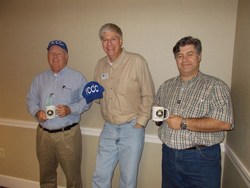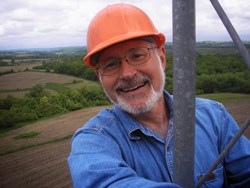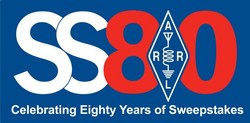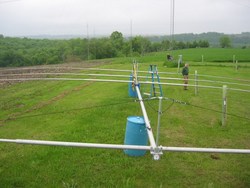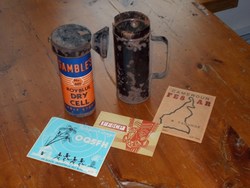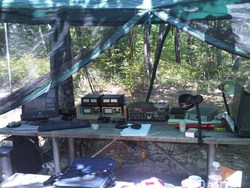 October 9, 2013 Editor: Ward Silver, NØAX | ||||||||
IN THIS ISSUE
NEW HF OPERATORS - THINGS TO DO If you are curious about what you can accomplish with CW QRP, the October Fall QRP QSO Party is a good way to find out. You can participate with QRP or full power output - the QRPers will be glad to work you. You can also try the Worked All Germany contest which is one of the more active single-country DX contests, similar to our own ARRL DX contests. BULLETINS Even with the U.S. government shutdown in full swing, the planned Morse code exercise to send 10 meter signals to the Juno spacecraft during its flyby of Earth is still on. (Kind of hard to shut down a spacecraft moving at several thousand miles per hour...) The JPL project managers confirm that Juno will be listening from 1800 to 2040 UTC, October 9th. The original webpage for the activity is now duplicated at the Juno mission website. If you experience problems with one page, simply load the other page - Preston Dyches, Juno Project Public Engagement Team. (Thanks, Bob, N6TV) BUSTED QSOS Glad to report nothing terribly broken in the previous issue. CONTEST SUMMARY Complete information for all contests follows the Conversation section October 12-13
October 19-20
You may have noted the demise of the popular VanityHQ website run by N4MC but the call sign history portion of the site is now is operational at the National Silent Key Archive. At the link under Tools > Research Hams, you can either enter a name or call sign and get the same table of information that was provided by VanityHQ. (Thanks, Dick N6AA)
The N1MM Logger team has begun a major re-write of the program in Visual Basic's .Net. The rewrite will also take advantage of the wide availability of multi-core computers for improved performance. The new version is expected to run under Windows XP, 7 and 8 with .Net 4 installed (The .Net 4 Framework is a free download from Microsoft). The re-write is expected to take from six months to one year. Everything will need to be thoroughly tested, and there likely be a need for volunteer testers, so please let the N1MM team know if you can help in that respect. (Thanks, Tom N1MM) MSRX is a new package of meteor scatter software developed by Klaus der Heide, DJ5HG. At least a few amateurs are using it in conjunction with WSJT here in the states. Both programs can run at the same time on your computer, allowing you to achieve a kind of "diversity" reception. (Thanks, Brian N3HJX) The story of the iPhone's creation has been packaged in this bite-sized techno-thriller in the pages of the New York Times. We may know how this story turned out but that doesn't make it any less exciting, especially for those of us who have worked in product development environments. (Thanks, Tim K3LR) Fans of acoustic music, analog recording, and pre-DSP radio will enjoy this recent EDN column, "Where Acoustic & Analog Still Rule the Roost," by Vincent Biancomano, who also happens to be WB2EZG. Are mechanical filters and analog noise blankers really the best? See what 'EZG thinks! (Thanks, Josh W6XU) Joe K1JT gave a well-received presentation on digital communication and the WSJT software package at the recent W9DXCC Convention. The presentation is available online as a PowerPoint file. (Thanks, Jim N7US)
The September issue of The GRAY LINE REPORT, the Twin Cities DX Association newsletter, has a couple of great stories you'll enjoy. First, Glenn WØGJ presents the trials and tribulations of moving a big station from Minnesota to Iowa - he needed an extra week in the year to do it! Then Bill WØOR tells the tale of operating from the Ecuadorian mountains in the 2013 ARRL DX CW contest. Lots of great pictures and story-telling! Ken WØKAH suggests "listening to air traffic controllers and pilots is good practice for keeping transmissions short and concise. The same goes for copying the clearances given to aircraft departing on instrument flight plans (all commercial flights departing a major airport). liveatc.net is an excellent resource that is available over the internet, free of charge. Listen to approach or departure control at any of the major airports for the traffic between pilots & controllers. For hard-core copy practice, listen to clearance delivery at Chicago, Boston, New York, etc. A good source for looking up airport codes is airnav.com, just click on Airports and enter a city or airport name, such as Kennedy, Logan, Boston, etc. You'll get a list of airports to choose from." That's one environment in which you definitely want 100% copy! Web Site of the Week - Ready for a real map-memory test? A landlocked country surrounded only by other landlocked countries may be called a "doubly landlocked" country. A person in such a country has to cross at least two borders to reach a coastline. There are currently two such countries in the world...no peeking at the atlas! (Thanks, Dave NN1N) WORD TO THE WISE 10-minute rule - often quite a surprise to the new multiops team, the 10 minute rule restricts band changes for some multi-operator categories for certain contests. The implementation of the rule depends on the contest - in some cases it has been replaced by a band change rule. The rule was designed to prevent the interleaving of QSO's on different bands for "single" transmitter categories by stations which actually have multiple transmitters on different bands. This would be a good rule to understand before the big CQ WW contests at the end of the month. (From the Contest University Glossary by Pat Barkey, N9RV)
Just in time for the 80th running of the ARRL November Sweepstakes, in this latest video, ARRL Contest Branch Manager Mike DeChristopher, N1TA, presents a brief history, rules review, a look at special awards for the 80th anniversary, and some tips & tricks from the real pros. The video will be presented live (free registration is required) on Tuesday, October 22 at 9 PM EDT and archived at some subsequent date. (Thanks, Ken K4ZW) Congratulations to Gary KN4AQ on Episode 100 of Ham Radio Now TV! What the heck was that?!?! An Alberta, Canada police officer's dashboard camera captured this very large fireball from a meteor's entry into the atmosphere. I'm awake! I'm awake! Even during relatively low-activity periods there is plenty of excitement on a very large ball of gas heated by nuclear fusion! You can see a long filament erupt of the surface of the Sun in the September 30th Spaceweather video. And yes, we felt it here on Earth! How is the Internet used, allocated, distributed, and managed around the globe? This collection of maps and graphics presents a lot of information interesting and thought-provoking ways.
The preliminary results are available for the 2013 Kansas QSO Party. Logs were due Oct 1 with results from 245 logs posted Oct 2. Two operators, N6MU and N8II have confirmed sweeps of all 105 Kansas counties! (Thanks, KSQP Coordinator, Bob WØBH) The full results for the 2012 Stew Perry Contest are now posted on the Stew Perry web page. This is also a reminder that the PreStew event is coming up on the weekend of Oct 19th - and the Big Stew will be on December 28/29th. (Thanks, Stew Perry Manager Tree, N6TR) OPERATING TIP In a previous issue, it was suggested to save your logging software configuration at the end of a contest after you've gotten it set up the way you wanted. Pete N4ZR noted that N1MM Logger does not save Function Key messages in the N1MM Logger's configuration file - they must be saved separately in a ".mc" file. This is typical of most logging software - messages are saved and recalled separately from the operating configuration. As Pete notes, "Many of us maintain a sub-directory full of past, "perfected" Function Key message files that we can call up." Pete's right and it's a good idea to have sets of messages for different styles of operating, too: fast/high-rate, slow/low-rate, Sunday afternoon, and so on.
How big is that antenna? Glenn WØGJ points out that his full-size 40 meter beam on a 50-foot boom covers 0.092 acres. (See photos in the newsletter mentioned previously.) Let's see, at 4047 square meters per acre, that's 372 square meters or 0.21 square wavelengths at 7.1 MHz if I did the math right. There's a new marketing metric for you - square wavelengths! How do they do that audio pitch-shifting thing? The theoretically-inclined among us might enjoy learning about the Constant-Q Transform, often employed in such signal processing antics. For resistors that must handle transient overloads, such as Beverage terminations, be sure to use a bulk composition type resistor, either metal-oxide or carbon, that can handle surges without changing value. Carbon film or metal film components increase in value after short duration, high-energy surges, because the surge blows part of the film layer away. Ohmite's OX/OY series of "Ceramic Composition" resistors are a good choice and available from many distributors. (Thanks, Mike W4EF) Here's a brief tutorial based on the Smith chart that shows what happens to an impedance as it is transformed via a length of transmission line. If you know the length of the feed line (in wavelengths including the velocity factor) you can transform impedances around the Smith chart and determine what the impedance of one end looks like from the other end. (Thanks,
Earl N8SS) When using coax to make a capacitor, do you connect both leads at one end or the shield at one end and the center conductor on the other? "Neither. Instead fold the coax and connect to both ends in parallel. In other words, connect the center conductors in parallel and the shields in parallel. This will greatly reduce the loss due to the resistance of the conductors." (Thanks, Rick N6RK) Need a control panel that says, "Set everything to 11!"? Brian N9ADG sent this great set of online instructions for etching your own brass panels for homebrew projects. Technical Web Site of the Week - Being in the process of installing some new towers and antennas, I'm using information on grounding from a variety of sources. Tom W8JI has provided a good web page on lightning protection with a number of helpful photos that may help you design your own station. You Have to Know the Territory In the previous issue, the Conversation section discussed visualization and how it provided data that could influence tactics and strategies in radiosport. Titling this essay with a quote from the musical, "Music Man," is meant as a caveat - that the visualization is itself not the competition. A set of statistics on players is not the game, no matter how complete, just as measurements of signal characteristics are not the contact. Radiosport is about, well, radio: the ability of competitors to use radio equipment and radio waves to contact other competitors. (This discussion is not about how the radio is operated, just the exchange of information using the equipment.) That's what the sport is about - having radio "know-how" and taking advantage of it.
The essential position of know-how in radiosport makes it important for us to retain as a central element of the sport. User interface technology and powerful software being what they are, it could be very easy to encapsulate radiosport in some kind of visually attractive metaphor for what is actually happening on the air. Imagine each signal having a visual avatar on a screen with its size determined by signal strength, for example. It might be easy to start forgetting that what we're really dealing with is signals. Here's an analogy: I used to develop industrial ultrasonic ranging equipment for level monitoring in bins of materials, tanks, chutes, and so on. The basic concept was "sonar in air," sending pulses of sound into the bin and watching for echoes, measuring the round trip time, and computing how much material was in the bin or silo or whatever enclosure. We regularly used oscilloscopes in the field to monitor the electronic signals in the ultrasonic receiver so we could see what the signal processing software would have to deal with in the way of reflections, obstructions, absorption, and noise. (Let me tell you, 1" aggregate falling out of a steel chute into a concrete bin makes a heck of a good white noise source...) It was very easy to start talking about "bumps" and "spikes" instead of "echoes" when devising strategies and tactics for making the measurements. The danger was, of course, that one would forget the real-world environment coloring and affecting the sound pulse returned to the receiver and then digitized for processing. In doing so, the system became an abstract game in which the entities that were acquired and manipulated were no longer physical entities. There were several instances in which errors occurred due to thinking about "bumps" and "spikes" that discounted real-world effects on the real-world echoes. The same can occur with visualizations that use real-world data, add some assumptions and algorithms, and present it as the game. As we get better and better at visualization, it will be more and more important to not lose sight of what the game really is. We have access to the playing fields of spectrum because our competitions improve radio know-how, not because we enjoy playing the game. To preserve the value of radiosport to the Amateur Service, we must insure that radio know-how is not just essential to being able to engage in radiosport, but that it is essential to success in radiosport. How we will accomplish this will be a challenge with each new innovation, especially as even the radios themselves become software and data, but rise to the challenge we must. We have to make sure that to win the game "you have to know the territory." October 9 to October 22 An expanded, downloadable version of QST's Contest Corral in PDF format is available. Check the sponsor's Web site for information on operating time restrictions and other instructions. HF CONTESTS North American RTTY Sprint--Digital, from Oct 13, 0000Z to Oct 13, 0400Z. Bands (MHz): 3.5-14. Exchange: Both call signs, serial, QTH, name. Logs due: 7 days. Rules School Club Roundup--Phone,CW,Digital, from Oct 21, 1300Z to Oct 25, 2359Z. Bands (MHz): 1.8-28, 50+. Exchange: RST, class and S/P/C. Logs due: 30 days. Rules 10-10 Sprint--Phone,CW,Digital, from Oct 10, 0001Z to Oct 10, 2359Z. Bands (MHz): 28. Exchange: Call, name, 10-10 number, S/P/C. Logs due: Oct 25. Rules NAQCC Monthly QRP Sprint--CW, from Oct 10, 0030Z to Oct 10, 0230Z. Bands (MHz): 3.5-14. Monthly on 2nd Tuesday or 3rd Wednesday local time (alternating). Exchange: RST, S/P/C, and NAQCC mbr nr or power. Logs due: 4 days. Rules Great Pumpkin Sprint--Digital, from Oct 12, 8 PM to Oct 13, 2 AM. Bands (MHz): 1.8. Exchange: RST and S/P/C. Logs due: 2 weeks. Rules Makrothen RTTY Contest--Digital, from Oct 12, 0000Z to Oct 13, 1600Z. Bands (MHz): 3.5-28. Exchange: 4-character grid square. Logs due: Nov 15. Rules Oceania DX CW Contest--CW, from Oct 12, 0800Z to Oct 13, 0800Z. Bands (MHz): 1.8-28. Exchange: RST and serial. Logs due: Oct 31. Rules Scandinavian Activity Contest--Phone, from Oct 12, 1200Z to Oct 13, 1200Z. Bands (MHz): 3.5-28. Exchange: RS and serial. Logs due: 2 weeks. Rules QRP ARCI Fall QSO Party--CW, from Oct 12, 1200Z to Oct 13, 2359Z. Bands (MHz): 1.8-28. Exchange: RS(T), S/P/C, QRP ARCI number or pwr. Logs due: 14 days. Rules Straight Key Weekend Sprintathon--CW, from Oct 12, 1200Z to Oct 13, 2359Z. Bands (MHz): 1.8-28, 50, Monthly on the second Saturday local time. Exchange: RST, QTH, name, SKCC nr or "none". Logs due: 5 days. Rules Arizona QSO Party--Phone,CW,Digital, from Oct 12, 1600Z - See website. Multiple time periods. Bands (MHz): 3.5-28, 50, 144, CW--1.812, 3.548, 7.048, 14.048, 21.048, 28.048, 50.048;SSB--1.848, 3.848, 7.189, 14.248, 21.348, 28.448, 50.148, 146.48 MHz. Exchange: Serial and S/P/C. Logs due: Oct 31. Rules EU Autumn CW Sprint--CW, from Oct 12, 1600Z to Oct 12, 2000Z. Bands (MHz): 3.5-14. Exchange: Both call signs, serial, name. Logs due: 15 days. Rules Pennsylvania QSO Party--Phone,CW,Digital, from Oct 12, 1600Z - See website. Multiple time periods. Bands (MHz): 1.8-28, 50,144, CW--40 kHz above band edge and 1.810; SSB--1.850, 3.825, 7.200, 14.280, 21.380, 28.480 MHz. Exchange: Serial and ARRL/RAC section. Logs due: Nov 14. Rules FISTS Fall Sprint--CW, from Oct 12, 1700Z to Oct 12, 2100Z. Bands (MHz): 3.5-28. Exchange: RST, S/P/C, name, FISTS number or pwr. Logs due: 30 days. Rules JARTS WW RTTY Contest--Digital, from Oct 19, 0000Z to Oct 20, 2400Z. Bands (MHz): 3.5-28. Exchange: RST and age (YL may send '00'). Logs due: Oct 31. Rules 10-10 Fall CW QSO Party--CW, from Oct 19, 0001Z to Oct 20, 2359Z. Bands (MHz): 28. Exchange: Call, name, 10-10 number, S/P/C. Logs due: Nov 4. Rules Iowa QSO Party--Phone,CW,Digital, from Oct 19, 1400Z to Oct 19, 2300Z. Bands (MHz): 1.8-28, 50+. Exchange: RS(T) and IA county, state/prov, or "DX". Logs due: Nov 20. Rules http://www.wa0dx.org New York QSO Party--Phone,CW,Digital, from Oct 19, 1400Z to Oct 20, 0200Z. Bands (MHz): 1.8-28, 50+, CW--1.820, 3.550, 7.050, 14.050, 21.050, 28.050; Phone--1.870, 3.825, 7.200, 14.290, 21.350, 28.400 MHz. Exchange: RS(T), NY county, state/prov, or "DX". Logs due: 14 days. Rules Worked All Germany--Phone,CW, from Oct 19, 1500Z to Oct 20, 1459Z. Bands (MHz): 3.5-28. See website. Exchange: RS(T) and serial or DOK code. Logs due: 2 weeks. Rules Stew Perry Warmup Contest--CW, from Oct 19, 1500Z to Oct 20, 1500Z. Bands (MHz): 1.8. Exchange: 4-char grid square. Logs due: 30 days. Rules W/VE Islands QSO Party--Phone,CW,Digital, from Oct 19, 1600Z to Oct 20, 2359Z. Bands (MHz): 1.8-28, 50. Exchange: RS(T) and S/P/C or island designator. Logs due: Nov 30. Rules Telephone Pioneer QSO Party--Phone,CW,Digital, from Oct 19, 1900Z - See website. Multiple time periods. Bands (MHz): 1.8-28, 50-432. Exchange: Year of membership and chapter. Logs due: Dec 10. Rules Spooky Feld-Hell Sprint--Digital, from Oct 19, 2000Z to Oct 19, 2200Z. Bands (MHz): 3.5-7,21-28. Exchange: RST, S/P/C, Feld-Hell member nr. Logs due: 2 weeks. Rules Asia-Pacific Sprint--CW, from Oct 20, 0000Z to Oct 20, 0200Z. Bands (MHz): 14-21. Exchange: RST and serial. Logs due: 7 days. Rules Illinois QSO Party--Phone,CW, from Oct 20, 1700Z to Oct 21, 0100Z. Bands (MHz): 1.8-28, 50,144. Exchange: RS(T) and IL county or S/P/C. Logs due: Nov 17. Rules Run For the Bacon--CW, from Oct 21, 0200Z to Oct 21, 0400Z. Bands (MHz): 1.8-28. Monthly on 3rd Sunday night (local). Exchange: RST, S/P/C, Flying Pig nr or power. Rules VHF+ CONTESTS School Club Roundup--Phone,CW,Digital, from Oct 21, 1300Z to Oct 25, 2359Z. Bands (MHz): 1.8-28, 50+. Exchange: RST, class and S/P/C. Logs due: 30 days. Rules 902+ MHz Fall VHF Sprint--Phone,CW,Digital, from Oct 12, 7 AM to Oct 12, 1 PM. Bands (MHz): 902+. Exchange: 6-character grid locator. Logs due: 4 weeks. Rules Straight Key Weekend Sprintathon--CW, from Oct 12, 1200Z to Oct 13, 2359Z. Bands (MHz): 1.8-28, 50, Monthly on the second Saturday local time. Exchange: RST, QTH, name, SKCC nr or "none". Logs due: 5 days. Rules Arizona QSO Party--Phone,CW,Digital, from Oct 12, 1600Z - See website. Multiple time periods. Bands (MHz): 3.5-28, 50, 144, CW--1.812, 3.548, 7.048, 14.048, 21.048, 28.048, 50.048;SSB--1.848, 3.848, 7.189, 14.248, 21.348, 28.448, 50.148, 146.48 MHz. Exchange: Serial and S/P/C. Logs due: Oct 31. Rules Arucaria VHF Contest--Phone,CW, from Oct 19, 0000Z to Oct 20, 1600Z. Bands (MHz): 50,144. Exchange: RS(T) and 4-char grid square. Logs due: 10 days. Rules Iowa QSO Party--Phone,CW,Digital, from Oct 19, 1400Z to Oct 19, 2300Z. Bands (MHz): 1.8-28, 50+. Exchange: RS(T) and IA county, state/prov, or "DX". Logs due: Nov 20. Rules http://www.wa0dx.org New York QSO Party--Phone,CW,Digital, from Oct 19, 1400Z to Oct 20, 0200Z. Bands (MHz): 1.8-28, 50+, CW--1.820, 3.550, 7.050, 14.050, 21.050, 28.050; Phone--1.870, 3.825, 7.200, 14.290, 21.350, 28.400 MHz. Exchange: RS(T), NY county, state/prov, or "DX". Logs due: 14 days. Rules Telephone Pioneer QSO Party--Phone,CW,Digital, from Oct 19, 1900Z - See website. Multiple time periods. Bands (MHz): 1.8-28, 50-432. Exchange: Year of membership and chapter. Logs due: Dec 10. Rules Illinois QSO Party--Phone,CW, from Oct 20, 1700Z to Oct 21, 0100Z. Bands (MHz): 1.8-28, 50,144. Exchange: RS(T) and IL county or S/P/C. Logs due: Nov 17. Rules LOG DUE DATES October 9 to October 22
ARRL Information Click here to advertise in this newsletter, space subject to availability. Your One-Stop Resource for Amateur Radio News and Information ARRL membership includes QST, Amateur Radio's most popular and informative journal, delivered to your mailbox each month. Subscribe to NCJ - the National Contest Journal. Published bimonthly, features articles by top contesters, letters, hints, statistics, scores, NA Sprint and QSO Parties. Subscribe to QEX - A Forum for Communications Experimenters. Published bimonthly, features technical articles, construction projects, columns and other items of interest to radio amateurs and communications professionals. Free of charge to ARRL members: Subscribe to The ARRL Letter (weekly digest of news and information), the ARES E-Letter (monthly public service and emergency communications news), Division and Section news -- and much more! ARRL offers a wide array of products to enhance your enjoyment of Amateur Radio. Visit the site often for new publications, specials and sales. Donate to the fund of your choice -- support programs not funded by member dues! Reprint permission can be obtained by sending email to permission@arrl.org with a description of the material and the reprint publication. ACKNOWLEDGEMENTS ARRL Contest Update wishes to acknowledge information from WA7BNM's Contest Calendar and SM3CER's Contest Calendar. | ||||||||
